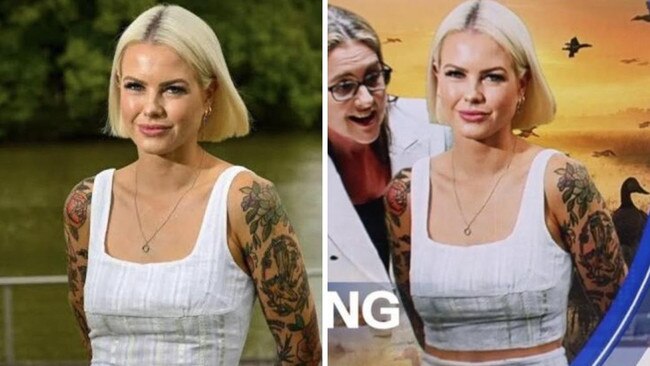
But this week, we’ve been talking about not just women’s busts in general, but one woman’s in particular, Victorian Animal Justice Party MP Georgie Purcell. Purcell has received an apology from the Nine Network after it broadcast a digitally altered image of her chest, making it noticeably larger. The change to her appearance also included the addition of a sliver of a cheeky midriff between a skirt and a top, replacing a demure, white dress she was in fact wearing in the original photo.
The network is now going tit for tat with Adobe, the maker of the software Nine is blaming for the incident. It says AI did it. Adobe isn’t having a bar of that defence. The company said in a statement that “changes to this specific image would have required human intervention and approval”.

It’s been many, many moons since I worked in a newsroom. However, my experience of producing graphics for TV is that blaming the software is, frankly, laughable. I don’t buy it.
Most of you will know I’m no gender-obsessed, third-wave radical feminist. In fact, I would never have even called myself one were it not for repeated attempts over past years to erase women and womanhood via ridiculous terms such as birthing parent and chest feeder. Nor am I a fanatical man-hater, who views every prism of life through the lens of gender and offence. Broadly, my view on men as a subset of the species is that I’m a huge fan.
This story, though, has ignited a righteous indignation within. It’s more than just an eye roll. It’s more than another example of the things that women in professional life must deal with day in, day out, that men simply never have to consider.
It’s about women as a commodity. As a cohort. Our worth. The rules, invisible and explicit, that we bend ourselves backwards trying to navigate. It’s about who calls the shots, and how we are perceived. Put simply, a different set of rules applies to us, and this case is just another example.
Pardon the soft crudeness of my analogy, but would a man have his hardware digitally augmented in such an overt way?
The rules are simply different.
Fellas, it’s not your fault but you never have to think about how your dress may be perceived when applied to your body type. If your shirt’s a little bit tight across the chest, for example, perhaps you’re festively plump or just exceptionally muscle bound, nobody is sexualising it. Nobody is having a sly wink behind your back.
I started my TV career with long hair. I was sent off to the hairdresser and made to look like Ray Martin. Then it was dyed blonde and cut even shorter.
A TV mate of mine, having once gone from blonde to brunette because she felt like it, was subsequently told “if I wanted a brunette, I’d have hired a brunette”. Not a drill, folks, and I can tell you, it doesn’t happen to men on camera or men in general.
The harsh reality is that women have been objectified and, yes, sexualised since time began. Perhaps it’s just human nature and the iteration of such behaviour modifies with time. I was in media for 10 years and have been in corporate life for nearly 21 and I can tell you with confidence that times have changed. The men in my corporate life are gentlemen in every sense of that phrase.
But what hasn’t changed is the fact that women remain the ultimate commodity. Once we were chattels, traded by fathers and brothers for power and dynasty; now we fill quotas and tick diversity boxes. When we succeed in our own right, as so many of us do, there’s always a question mark about merit.
It’s complicated, isn’t it? Because even though we have come so far, the fact that a woman had her body digitally altered to augment her breasts and display a midriff that was previously hidden shows we’re not there yet.
Can I also propose that women are also a very useful social barometer of sorts. What I mean by this is that the way a society treats women is a very telling measure of its moral compass and broader values.
In the coverage of this story, we are repeatedly reminded that Purcell used to be a stripper. Is this some kind of bizarre justification for altering her appearance?
Is she the wrong kind of woman? You know, the one that’s fair game. I’ve spoken about this before, how sections of the media decide who is worth defending and who is not. Who they will champion and defend, and which women we let languish and fend for themselves. Conservative women are absolutely fair game, for example, but there is no more powerful example of women who are fair game than those caught in the war against Hamas. Right now, Israeli women are being used as sex slaves for Hamas terrorists, deep in Gaza. Are they the wrong kind of women? You’d be forgiven for thinking so. Nobody’s marching in the street demanding their freedom and when you stop and think about the relentless, sexual abuse they’ve been enduring for more than 100 days it is enough to make you feel sick. They would have us forget, stop talking about them. I will not stop until they’re free.
Back to the image of Georgie Purcell. However that picture was altered, the fact that it happened simply shows us how far we still have to go.






I’ve never understood the fascination with a woman’s chest. Trust me, as the bona fide owner of an original set (no renovations in half a century, that’s saying something) and as an adult human female who carts them around day in, day out, it’s not something I’m unfamiliar with. However, women don’t, in my experience, engage in weird comparisons and competitions in relation to size. Size is a pain in the back when it comes to your front. And that’s before you start talking about sports bras, bathers, bikinis and backless dresses. I could write a book on how to deal with these micro-traumas. Sorry to burst your bubble, folks, but most gals don’t understand the fuss.